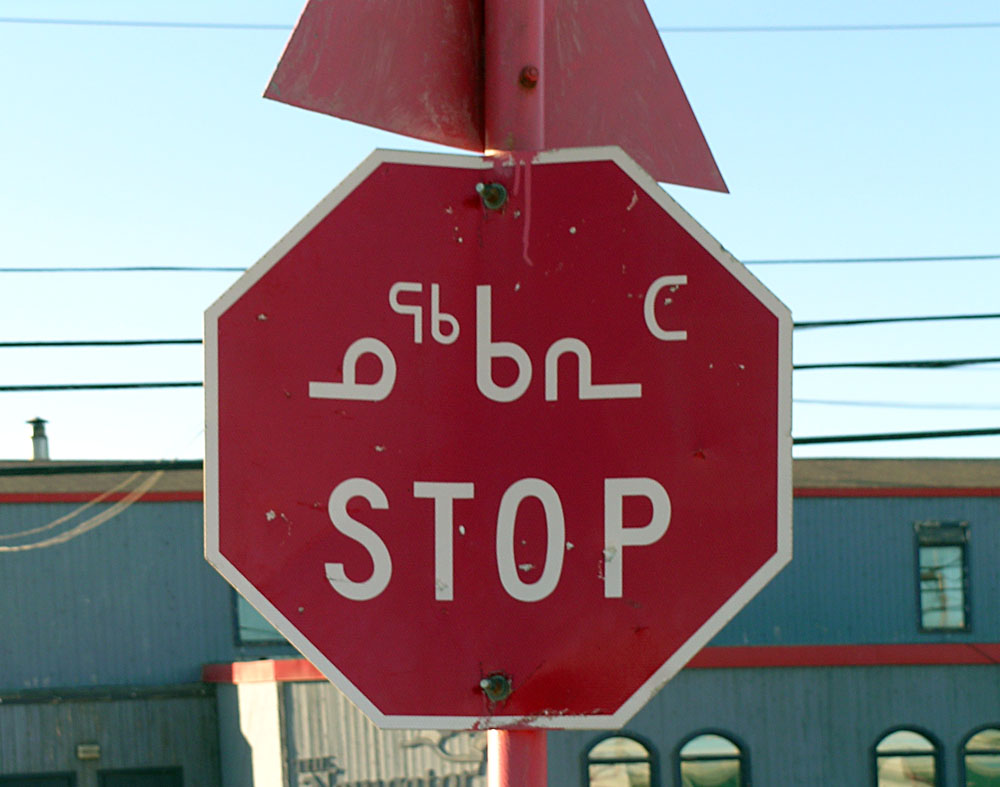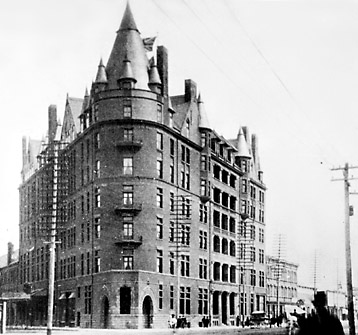|
Victoria Mamnguqsualuk
Victoria Mamnguqsualuk (sometimes Mamnguksualuk) (Inuktitut syllabics: ) (1930-2016) was one of the best-known Canadian Inuit artists of her generation. Early life Born near Garry Lake, Mamnguqsualuk passed a nomadic youth until her thirties, when in 1963, to avoid starvation, her family moved to Baker Lake. Mamnguqsualuk is one of noted Inuit artist Jessie Oonark's eight artistically gifted children; among her siblings are the artists Nancy Pukingrnak, Josiah Nuilaalik, Janet Kigusiuq, Mary Yuusipik Singaqti, Miriam Nanurluk, and William Noah. Her husband, Samson Kayuryuk, and son, Paul Aglakuaq Kayuryuk, are also artists. Work She is best known for her silkscreen and stencil, prints, but has worked in sculpture, drawings, and fabrics as well. Mamnguqsualuk's bold depictions of Inuit myth have been widely praised. Like her mother, she moves easily between the realms of graphic arts and textiles. Eight of her prints were part of the first print edition from Baker Lake, in ... [...More Info...] [...Related Items...] OR: [Wikipedia] [Google] [Baidu] |
Inuktitut Syllabics
Inuktitut syllabics ( iu, ᖃᓂᐅᔮᖅᐸᐃᑦ, qaniujaaqpait, or , ) is an abugida-type writing system used in Canada by the Inuktitut-speaking Inuit of the territory of Nunavut and the Nunavik and Nunatsiavut regions of Quebec and Labrador, respectively. In 1976, the Language Commission of the Inuit Cultural Institute made it the co-official script for the Inuit languages, along with the Latin script. The name derives from the root , meaning "mouth". The alternative, Latin-based writing system is named (), and it derives from , a word describing the markings or the grain in rocks. meaning "new writing system" is to be seen in contrast to (), the "old syllabics" used before the reforms of 1976. History The first efforts to write Inuktitut came from Moravian missionaries in Greenland and Labrador in the mid-19th century using Latin script. The first book printed in Inuktitut using Cree script was an 8-page pamphlet known as ''Selections from the Gospels in the di ... [...More Info...] [...Related Items...] OR: [Wikipedia] [Google] [Baidu] |
Winnipeg Art Gallery
The Winnipeg Art Gallery (WAG) is an art museum in Winnipeg, Manitoba, Canada. Its permanent collection includes over 24,000 works from Canadian, Indigenous Canadian, and international artists. The museum also holds the world's largest collection of Inuit art. In addition to exhibits for its collection, the museum has organized and hosted a number of travelling arts exhibitions. Its building complex consists of a main building that includes of indoor space and the adjacent Qaumajuq building. The present institution was formally incorporated in 1963, although it traces its origins to the Winnipeg Museum of Fine Arts, an art museum opened to the public in 1912 by the Winnipeg Development and Industrial Bureau. The bureau opened the Winnipeg School of Arts in the following year, and operated the art museum and art school until 1923, when the two entities were incorporated as the Winnipeg Gallery and School of Arts. In 1926, the Winnipeg Art Gallery Association was formed to ass ... [...More Info...] [...Related Items...] OR: [Wikipedia] [Google] [Baidu] |
Inuit Printmakers
Inuit (; iu, ᐃᓄᐃᑦ 'the people', singular: Inuk, , dual: Inuuk, ) are a group of culturally similar Indigenous peoples of the Americas, indigenous peoples inhabiting the Arctic and subarctic regions of Greenland, Labrador, Quebec, Nunavut, the Northwest Territories, and Alaska. Inuit languages are part of the Eskimo–Aleut languages, also known as Inuit-Yupik-Unangan, and also as Eskaleut. Inuit Sign Language is a critically endangered language isolate used in Nunavut. Inuit live throughout most of Northern Canada in the Provinces and territories of Canada, territory of Nunavut, Nunavik in the northern third of Quebec, Nunatsiavut and NunatuKavut in Labrador, and in various parts of the Northwest Territories, particularly around the Arctic Ocean, in the Inuvialuit Settlement Region. With the exception of NunatuKavut, these areas are known, primarily by Inuit Tapiriit Kanatami, as Inuit Nunangat. In Canada, Section 25 of the Canadian Charter of Rights and Freedoms, sec ... [...More Info...] [...Related Items...] OR: [Wikipedia] [Google] [Baidu] |
Women Printmakers
A woman is an adult female human. Prior to adulthood, a female human is referred to as a girl (a female child or adolescent). The plural ''women'' is sometimes used in certain phrases such as "women's rights" to denote female humans regardless of age. Typically, women inherit a pair of X chromosomes, one from each parent, and are capable of pregnancy and giving birth from puberty until menopause. More generally, sex differentiation of the female fetus is governed by the lack of a present, or functioning, SRY-gene on either one of the respective sex chromosomes. Female anatomy is distinguished from male anatomy by the female reproductive system, which includes the ovaries, fallopian tubes, uterus, vagina, and vulva. A fully developed woman generally has a wider pelvis, broader hips, and larger breasts than an adult man. Women have significantly less facial and other body hair, have a higher body fat composition, and are on average shorter and less muscular than men. Throu ... [...More Info...] [...Related Items...] OR: [Wikipedia] [Google] [Baidu] |
Canadian Printmakers
Canadians (french: Canadiens) are people identified with the country of Canada. This connection may be residential, legal, historical or cultural. For most Canadians, many (or all) of these connections exist and are collectively the source of their being ''Canadian''. Canada is a multilingual and multicultural society home to people of groups of many different ethnic, religious, and national origins, with the majority of the population made up of Old World immigrants and their descendants. Following the initial period of French and then the much larger British colonization, different waves (or peaks) of immigration and settlement of non-indigenous peoples took place over the course of nearly two centuries and continue today. Elements of Indigenous, French, British, and more recent immigrant customs, languages, and religions have combined to form the culture of Canada, and thus a Canadian identity. Canada has also been strongly influenced by its linguistic, geographic, and ec ... [...More Info...] [...Related Items...] OR: [Wikipedia] [Google] [Baidu] |
2016 Deaths
This is a list of deaths of notable people, organised by year. New deaths articles are added to their respective month (e.g., Deaths in ) and then linked here. 2022 2021 2020 2019 2018 2017 2016 2015 2014 2013 2012 2011 2010 2009 2008 2007 2006 2005 2004 2003 2002 2001 2000 1999 1998 1997 1996 1995 1994 1993 1992 1991 1990 1989 1988 1987 See also * Lists of deaths by day The following pages, corresponding to the Gregorian calendar, list the historical events, births, deaths, and holidays and observances of the specified day of the year: Footnotes See also * Leap year * List of calendars * List of non-standard ... * Deaths by year {{DEFAULTSORT:deaths by year ... [...More Info...] [...Related Items...] OR: [Wikipedia] [Google] [Baidu] |
1930 Births
Year 193 ( CXCIII) was a common year starting on Monday (link will display the full calendar) of the Julian calendar. At the time, it was known as the Year of the Consulship of Sosius and Ericius (or, less frequently, year 946 '' Ab urbe condita''). The denomination 193 for this year has been used since the early medieval period, when the Anno Domini calendar era became the prevalent method in Europe for naming years. Events By place Roman Empire * January 1 – Year of the Five Emperors: The Roman Senate chooses Publius Helvius Pertinax, against his will, to succeed the late Commodus as Emperor. Pertinax is forced to reorganize the handling of finances, which were wrecked under Commodus, to reestablish discipline in the Roman army, and to suspend the food programs established by Trajan, provoking the ire of the Praetorian Guard. * March 28 – Pertinax is assassinated by members of the Praetorian Guard, who storm the imperial palace. The Empire is auctioned o ... [...More Info...] [...Related Items...] OR: [Wikipedia] [Google] [Baidu] |
Glenbow Museum
The Glenbow Museum is an art and history regional museum in the city of Calgary, Alberta, Canada. The museum focuses on Western Canadian history and culture, including Indigenous perspectives. The Glenbow was established as a private non-profit foundation in 1955 by lawyer, businessman and philanthropist Eric Lafferty Harvie with materials from his personal collection. The museum moved to its current facility in downtown Calgary in 1976, and is funded by the governments of Calgary, Alberta and Canada, private donors, as well as an endowment provided by Harvie. In 2019, the Glenbow had a total of 148,668 visitors. The museum closed temporarily for renovations in 2021, and will re-open in 2024. Admission to the museum is free as of February 2022, due to a $25 million donation by the Shaw Family Foundation. $15 million of the donation will be placed in an endowment fund for admissions, and $10 million is earmarked for the new JR Shaw Institute for Canadian Art. History Ea ... [...More Info...] [...Related Items...] OR: [Wikipedia] [Google] [Baidu] |
National Gallery Of Canada
The National Gallery of Canada (french: Musée des beaux-arts du Canada), located in the capital city of Ottawa, Ontario, is Canada's national art museum. The museum's building takes up , with of space used for exhibiting art. It is one of the largest art museums in North America by exhibition space. The institution was established in 1880 at the Second Supreme Court of Canada building, and moved to the Victoria Memorial Museum building in 1911. In 1913, the Government of Canada passed the ''National Gallery Act'', formally outlining the institution's mandate as a national art museum. The museum was moved to the Lorne building in 1960. In 1988, the museum was relocated to a new building designed for this purpose. The National Gallery of Canada is situated in a glass and granite building on Sussex Drive, with a notable view of the Canadian Parliament buildings on Parliament Hill. The building was designed by Israeli architect Moshe Safdie and opened in 1988. [...More Info...] [...Related Items...] OR: [Wikipedia] [Google] [Baidu] |


.jpg)

